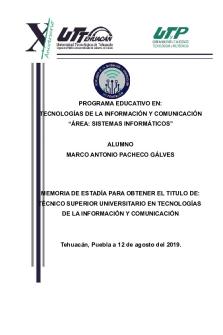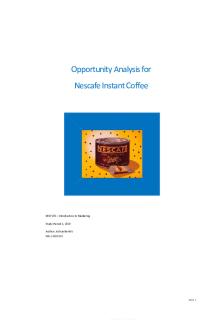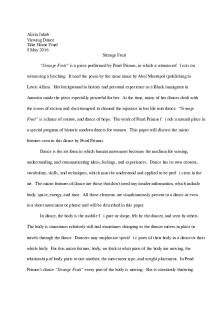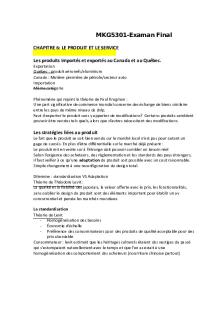Moana final PDF

| Title | Moana final |
|---|---|
| Course | Introductory Psychology 2 |
| Institution | Indiana University Bloomington |
| Pages | 8 |
| File Size | 154.5 KB |
| File Type | |
| Total Downloads | 93 |
| Total Views | 133 |
Summary
final mandatory assignment of the year worth 30% of grade ...
Description
Running head: MOANA AND DEVELOPMENT
Moana and Development Hope Buchan Elon University
1
2
MOANA AND DEVELOPMENT Moana and Development The movie Moana follows an emerging adolescent named Moana on her journey to restore her island’s resources by returning the heart of Te Fiti to its rightful owner. Moana finds
the demigod Maui who guides her in becoming a way-finder. They are able to navigate the ocean and return the heart of Te Feti, and in turn save the village. Overall, the movie is an accurate portrayal of lifespan development concepts including low self-esteem and its effects on a person’s behavior and ability to take on challenges (Laible, Carlo, & Roecsh, 2004), as well illstructured problems. Other themes within the movie that are accurate representations of lifespan development are attachment and internal working models as well as Erikson’s stages, and epistemological beliefs. Not all aspects of development are depicted correctly however with the misrepresentation of typical friendships during adolescence and early adulthood. These aspects of development are intertwined in all aspects of an individual’s life. As not all aspects of development are depicted correctly, it is obvious to developmental scholars that this is a movie produced based on knowledge of society not necessarily in-depth knowledge of cognitive, social, emotional, or physical development. Attachment and Internal Working Models Maui confides in Moana about his troubled childhood while they are sailing and describes the tragic story of his parents abandoned him at birth near the ocean. Maui explains that he spent his entire childhood and early adulthood trying to please others by preforming extraordinary acts in order to get their attention and praise. This story gives light to the fact that Maui has a poor internal working model of relationships and since his relationship with his family was so poor, he looks to his peers and the people of the island for affirmation (Berk, 2018). His constant need for reassurance and acceptance is what lead him to steal the heart of Te
MOANA AND DEVELOPMENT
3
Fiti and in turn cause depletion of Moana’s islands resources. It is clear that Maui’s character has an accurate representation of a poor internal working model through his ways of thinking and view of himself. Throughout the movie Maui is reliant on his hook and placed his value and worth in it. When his hook gets cracked he becomes hard and depressed because he feels as though he is worthless without it. The movie accurately depicts Maui as having low self-esteem because he does not believe he has any value without his hook (Berk, 2018). This is consistent with research that shows someone with low self-esteem has low self-confidence and his reluctance to take on challenges (Laile et al. 2004). He places his worth in an external object instead of within himself implying that he does not feel as if he has much worth. This way of thinking may able be attributed to learned helplessness that Maui has developed due to the hook and the power it has given him in the past (Berk, 2018). Maui is momentarily willing to give up on the mission when his hook is cracked because he would rather have a cracked hook and not save the islands than risk breaking his hook and save the islands. As accurately depicted in the movie, Moana has a secure base in her grandmother (Berk, 2018). Moana turns to her grandmother in times of need, which is also characteristic of a secure base. This is seen when her grandmother is dying and affirms Moana’s decision to go on the journey and return the heart of Te Fiti. Further, Moana’s grandmother appears to her as a reincarnated sting ray when Moana nearly gives up on her mission. However, this is an accurate representation of a secure base, as Moana is still able to have satisfying relationships with others, such as Maui during their voyage, without being too dependent on her grandmother’s advice or support (Berk, 2018). Erikson’s Stages
MOANA AND DEVELOPMENT Moana searches for her identity while on her journey. Moana could have accepted her identity as the village leader she chooses to peruse her true identity as way finder. It is typical of emerging adults and adolescences to change their path in life and explore different callings and Moana’s internal struggle is accurately representing the struggle between Erikson’s identity versus role confusion (Berk, 2018). Identity defines who you are, what you value, and your direction in life (Berk, 2018). At the beginning of the movie, she forecloses on the idea to become the next leader of the village but then enters moratorium while she explores the ocean at her grandmother’s insistence and journeys with Maui to Te Fiti (Berk, 2018). The scene when her and Maui are sailing back to her village is when she finds her true identity as a way finder. Upon arriving back to her community, she teaches the rest of the villagers to sail and find resources, by doing so she commits to her true identity as a way finder and leader. Throughout this journey, Moana’s father was in middle adulthood and was experiencing Erikson’s conflict of generativity versus stagnation. Generativity is the interest in guiding the next generation to work towards a better future (Berk, 2018). This is seen when he teaches Moana the duties of the chief and guiding her so she knows how to run the village and better the lives of their people in the future, which is frequently seen in adults this age especially within positions of power (Berk, 2018). Her father is also facing many of the daily stressors that are common in middle adulthood such as work struggles in trying to save the island and find new resources as well as taking care of a child while trying to keep Moana away from the water, and taking care of an elderly parents while his mom was sick (Berk, 2018). Moana’s father was therefore a part of the sandwich generation, taking care of his children and his mother (Berk, 2018). This aspect of Moana’s father’s life is one that is common in many adults his age and his stressors are typical given the situation he is in (Blanchard-Fields, 2007). The daily pressure of
4
MOANA AND DEVELOPMENT
5
resorting the islands resources, is an ill-structured problem that cannot be describes completely or solved with certainty. As the Chief Moana’s father is responsible for ensuring the safety and livelihood of the villagers. The solution of going out past the reef to find food and other resources will certainly put the villagers at risk, but they are also unable to continue as a functioning community if they do not try to use the alleged legends to find and return the heart of Te Fiti. While this might seem like a solution no one knows if this story is just a legend and if it can be done or is true. These types of issues and stress are typically handled by managing stress and using breathing techniques or common stressing activities. These types of coping mechanisms are not seen in the move, while the issues themselves are common a coping mechanism is not in play to handle the ill-structured problem (Blanchard-Fields, 2007). Epistemological Beliefs Moana’s grandmother is at a point of committed relativism in her life where she can make a conscious choice about the truth (Berk, 2018). She has seen the dangers of going out past the reef in that the last people to do so were fatally injured. However, as she says to Moana she knows that to save her island, it is imperative to at least attempt to try. She has accepted that she will not be the one to save the island but chooses to encourage Moana to be brave and take on the task. The grandmother chooses going past the reef as her personal truth in order to return the heart and save the village. The grandmothers committed relativism is portrayed accurately as she has weighed the options and chosen her truth (Berk, 2018). She also correctly exhibits crystalized in that she has knowledge and experience pertaining to Moana’s ability to go beyond the reef. She has seen and heard stories of past villager’s journeys and knows that it is necessary based on past villager’s experiences and success in going past the reef. The grandmother also only shares this knowledge with Moana because she knows that she will be the only one to
MOANA AND DEVELOPMENT
6
understand the value of knowing that their decedents were voyagers because of the villager’s overall outlook towards these dangers. Moana’s father tells the story of his best friend dying while sailing beyond the reef. After this tragic event, the father blamed himself and ensured that no one else would ever be hurt in the same way. He tries to find alternative sustainable ways of living and teaches Moana and the rest of the village these tactics. The father exhibits Levinson’s task of middle adulthood, destruction versus creation (Berk, 2018). He acknowledges part hurtful actions, but tries to correct these and leave a legacy for future generations in teaching Moana to run the village safely. Friendships Friendships created during middle childhood and early adolescence typically provide affirmation, acceptance, support. The results of a study show that friends are also normally similar ages, socioeconomic status, race, and personality (Haselager, Hartup, Lieshout, & Riksen-Walraven, 1998). Typically, Moana would befriend people around the same age as her that are also adventurous and of a higher social standing (Haselager et al. 1998). Maui and Moana showcase friendship in the scenes during their journey to Te Fiti. Maui helps her become autonomous by teaching her the skills to be a way finder. He is also there as a support in times of stress when she tries to return the heart but cannot do it alone. However, their friendship is atypical in that they are not similar in age, socioeconomic status, or personality and does not accurately depict friendships in middle childhood (Haselager et al. 1998). Their friendship was also not founded in a characteristic way. Maui is forced on the journey by Moana and tried to leave several times once he regains his hook. Also, being a demigod places Maui in a higher social class than Moana which would limit their interaction in society (Haselager et al. 1998).
MOANA AND DEVELOPMENT
7
Eventually however, their tolerance of each other grew into a friendship due to their common goal. Conclusion The movie Moana encompasses many aspects of the lifespan across many different stages of cognitive, social, emotional, and physical development. Within these areas of development, the producers correctly depict stages of development and concepts associated with them such as attachment and internal working models, Erikson’s stages, and epistemological beliefs. However, not all areas of development were discussed in this review and there may be additional sources of error within the movie. The aspects of Moana and Maui’s friendship are uncharacteristic of those experienced by adolescence and early adults. Overall, Moana is an accurate portrayal of development through the lifespan despite small discrepancies.
MOANA AND DEVELOPMENT
8
References Berk, L. E. (2018). Development through the lifespan. Hoboken, NJ: Pearson. Blanchard-Fields, F. (2007). Everyday Problem Solving and Emotion: An Adult Developmental Perspective. Current Directions in Psychological Science, 16(1), 26–31. Haselager, J., Hartup, W. W., Lieshout, C. F. M. & Riksen-Walraven, J. M. A. (1998). Similarities between Friends and Nonfriends in Middle Childhood. Child Development, 69(4), 1198– 1208. https://doi.org/10.2307/1132369 Laile, D. J., Carlo, G., & Roesch, S. C. (2004). Pathways to Self-esteem in Late Adolescence: The Role of Parent and Peer Attachment, Empathy, and Social Behaviors. Journal of adolescence, 27(6) 703-716....
Similar Free PDFs

Moana final
- 8 Pages

Final
- 9 Pages

Tesina-Final reevisado Final
- 55 Pages

🎄🎄🎄🎄🎄🎄 - Final
- 2 Pages

Opportunity Analysis final final
- 12 Pages

Examen final bioquímica final
- 12 Pages

THESIS FINAL FINAL
- 84 Pages

Final
- 3 Pages

Final
- 16 Pages

Final
- 37 Pages

Flipped-final - FLIPPED FINAL
- 6 Pages

Final Final Essay Africa
- 8 Pages

Examen final bioquímica final
- 12 Pages

Trabajo Final CAF2 Final
- 24 Pages

Final Exam -Evaluacion final
- 42 Pages

Practice-final - Practice final
- 7 Pages
Popular Institutions
- Tinajero National High School - Annex
- Politeknik Caltex Riau
- Yokohama City University
- SGT University
- University of Al-Qadisiyah
- Divine Word College of Vigan
- Techniek College Rotterdam
- Universidade de Santiago
- Universiti Teknologi MARA Cawangan Johor Kampus Pasir Gudang
- Poltekkes Kemenkes Yogyakarta
- Baguio City National High School
- Colegio san marcos
- preparatoria uno
- Centro de Bachillerato Tecnológico Industrial y de Servicios No. 107
- Dalian Maritime University
- Quang Trung Secondary School
- Colegio Tecnológico en Informática
- Corporación Regional de Educación Superior
- Grupo CEDVA
- Dar Al Uloom University
- Centro de Estudios Preuniversitarios de la Universidad Nacional de Ingeniería
- 上智大学
- Aakash International School, Nuna Majara
- San Felipe Neri Catholic School
- Kang Chiao International School - New Taipei City
- Misamis Occidental National High School
- Institución Educativa Escuela Normal Juan Ladrilleros
- Kolehiyo ng Pantukan
- Batanes State College
- Instituto Continental
- Sekolah Menengah Kejuruan Kesehatan Kaltara (Tarakan)
- Colegio de La Inmaculada Concepcion - Cebu